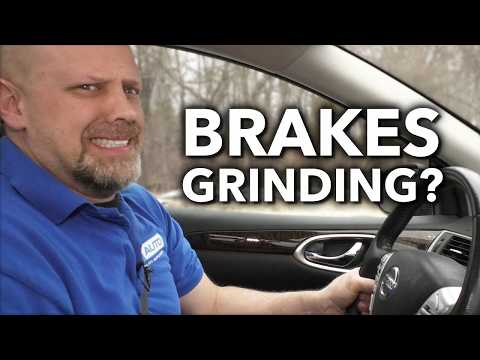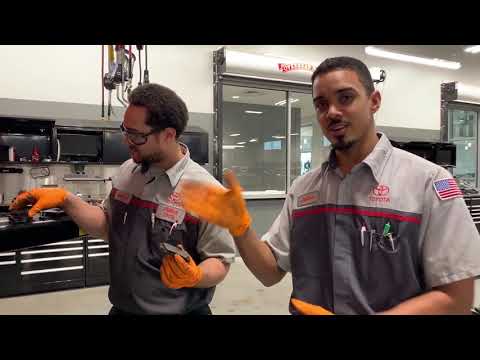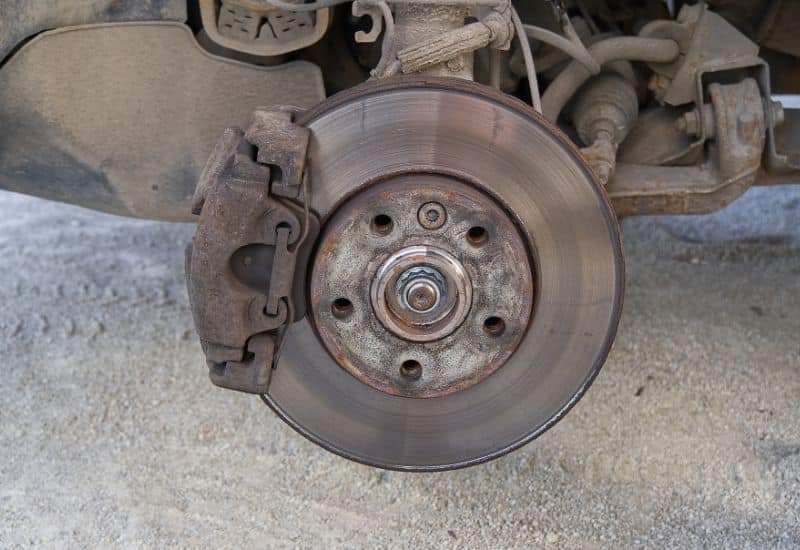
Most modern cars have disc brakes with rotors in each wheel hub. When you step on your brake pedal, a hydraulic system depresses the calipers on each wheel, which presses the brake pads into the smooth surface of the rotors, creating enough friction to slow the car down.
However, if the rotors’ surface becomes deformed or warped, the brake pads don’t meet the rotors smoothly, making it hard to slow the car down safely. Not to mention, a severely warped rotor can cause the car, the brake pedal, and the steering wheel to shutter unnervingly. This warping is often caused by the excessive heat generated during braking, which can lead to an uneven surface on the brake rotors over time.
If you’ve been noticing symptoms of warped rotors, such as increased braking distance, a burning rubber smell, a metallic grinding sound when stepping on the brakes, vibration on the steering wheel, or braking that makes the car shake, you should be concerned about the condition of your brakes.
Let’s take a closer look at the warning signs of a warped brake rotor, the causes of brake rotor warping, and what it means to have one.
What does it mean if you have warped rotors?
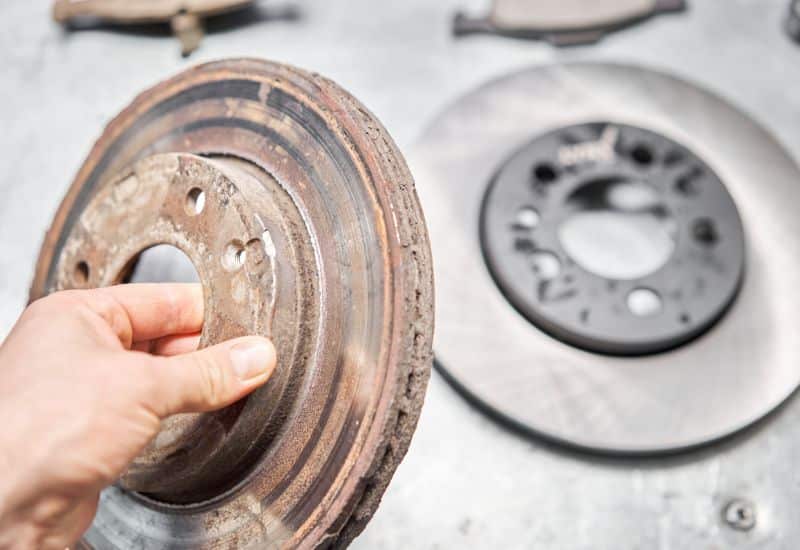
Normal rotors are smooth and might have some small channels or holes in them to help dissipate the friction heat from braking. Things like excessive braking, hard braking, and riding the brake downhill can create an enormous amount of heat, which can stress the iron rotor, causing it to deform slightly. If it happens enough, the surface of the rotor can deform or become warped.
When this happens, the relatively smooth surface of the brake pads doesn’t make full contact with the rotor when you step on the brakes. Over time, this can compound the problem, causing grooves in the surface of the rotor, as well as excess heat, which can cause the metal rotor to deform more.
It’s also possible for some of the brake pad material to get so hot that it transfers to the rotor or “Glazes” the surface. This further worsens the deformation on the surface of the warped rotor and increases the car’s braking distance while shortening the life of the brake pad. However, this is more likely to happen with organic brake pads, which are made up of an amalgam of relatively soft materials.
Is Your Car Experiencing a Warped Brake Rotor? Here’s How to Tell
The early signs of warped rotors often start out subtly, like squealing brakes and slightly longer braking distance. As the deformation on the surface of the rotor worsens, you’ll start to notice more severe signs that your brakes are in trouble.
You may notice one or more of the following symptoms if you have warped rotors:
1. Squealing Sounds When Braking
The uneven surface of warped rotors prevents the brake pads from meeting smoothly, causing a squeaking or squealing noise. This is usually one of the earliest signs of warped rotors, and if you ignore it for too long, it could shorten the lifespan of your brake pads as well.
2. Increased Braking Distance
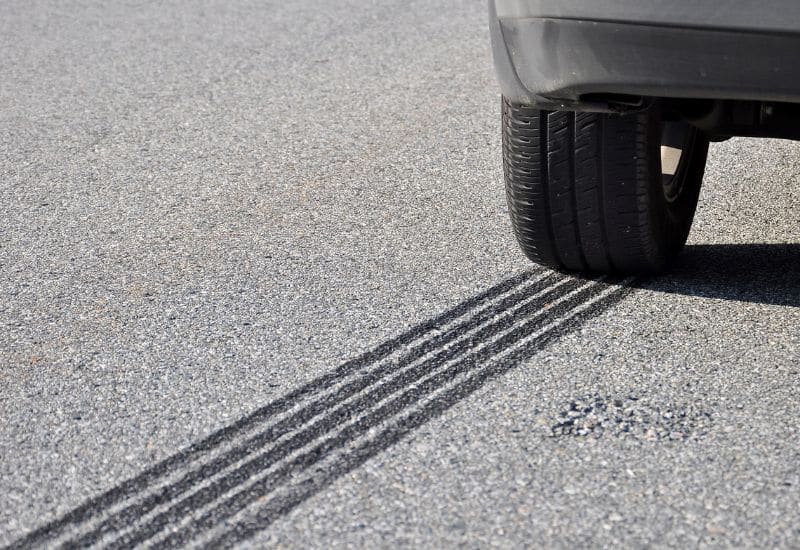
When the brake pads can’t make full contact with the surface of your warped rotors, it inevitably takes longer for the car to slow down. You might not notice this at first, but as the pads suffer, your braking distances will get uncomfortably longer, especially when you’re trying to slow down from highway speed to a dead stop.
3. Vibrating Brake Pedal
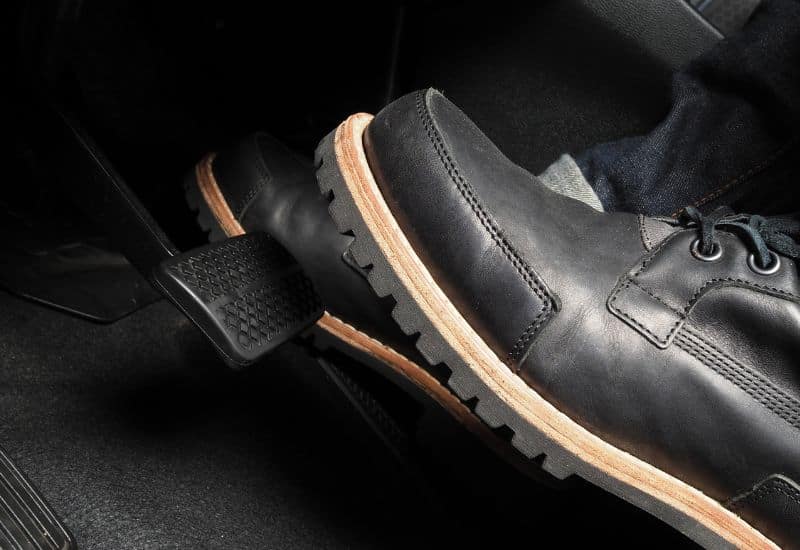
A vibrating brake pedal is one of the surest signs that you’ve got one or more warped rotors. Early on, you might only notice a shuddering in the brake pedal when you have to brake hard or slow down from highway speed. As the deformation on the surface of the rotor worsens and the brake pads wear unevenly, the vibration in the brake pedal will start to happen at low speeds as well.
Another concern with a vibrating brake pedal is that the warped rotors can cause the brake pad to come loose from the caliper partially. The pad stays in the caliper but is grossly misaligned and will grind away on the rotor unnaturally with each brake pedal press. This leads to ugly grooves in the rotor that also affect braking performance.
4. Vibrating Steering Column

It doesn’t take long for the warped rotor vibration in the brake pedal to progress into the steering column. Here again, the vibration will be most noticeable when braking hard or slowing down from highway speed. Then you’ll start to notice it even at low-speed braking.
This should also increase your suspicion that you’re suffering severe brake pad damage or that part of at least one brake pad is no longer mounted properly in the caliper. A vibrating steering column is usually a sign that the front rotors are warped.
5. Body Vibration

Warped back rotors sometimes cause the car’s body to vibrate without any excess shuddering in the brake pedal or steering wheel. This is more likely to be the case if you had your front rotors replaced in the last 10,000 miles but didn’t need the back rotors replaced at that time.
6. Grinding Noises When Braking
Grinding noises when braking is a sign that your warped rotor is now making contact with the caliper or the brake pad is grossly worn away. Just like the vibrations, the grinding will usually start when slowing down from highway speed or times when you need to stop short.
7. Burning Rubber Odors
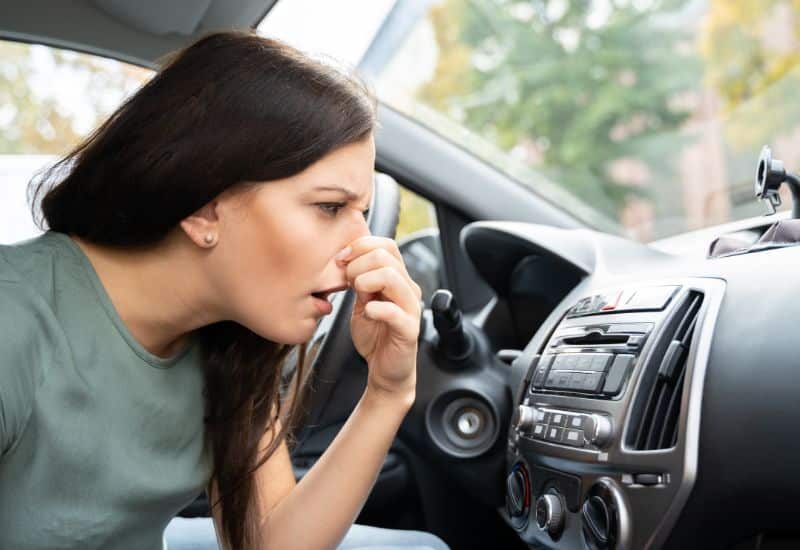
If you have warped rotors with organic brake pads or brake pads with rubber shims, you might also notice a faint odor of burning rubber after braking hard. There’s usually a delayed reaction, where you stop short at a red light or a busy crosswalk, and then a few seconds later, the burning rubber odor wafts into the cab.
This could be a sign that the amalgam of the brake pad is starting to glaze the surface of the warped rotor as the pad wears unevenly. If it’s happening right after you hear a grinding noise, then it likely means the caliper is starting to kiss the warped rotor, and it’s wearing off some of the brake pad’s rubber shim.
8. A Metallic Hiss or Grinding Noise After Take Off
Severely warped rotors that have worn off most or all of the brake pads can cause the brake caliper to stick. You grind to a stop at a red light or a stop sign, then take off again, only to hear a metallic hissing or grinding noise that slowly gets better after a few seconds.
This is a sign that your brakes are in very serious trouble of failing. At this point, the damage to the caliper can cause a leak in the hydraulic brake line, which will rapidly bleed all the pressure out of the system with every step of the brake pedal.
Factors That Can Cause A Warped Brake Rotor In A Car
Excess heat from braking friction is the more common cause of warped rotors. This can come from various sources beyond just the regular wear and tear of everyday braking.
1. Driving Habits
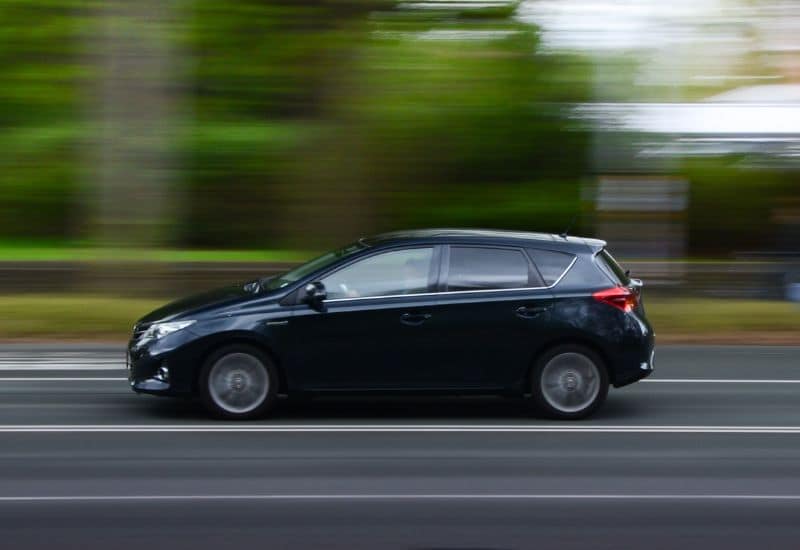
If you’re the type of person who loves to drive a little too fast and then brakes hard at the last possible second, your driving habits could be the underlying cause of warped rotors. The friction between the brake pads and rotors can be severe if you’re going fast and stepping down hard on the brake pedal. This produces a lot of heat energy, which can start to stress the metal structure of the rotor, causing it to deform gradually.
2. Driving on Hills And Riding the Brake

If you live in a hilly area and you often have to ride the brake downhill or make hard stops at the bottom of the hill, your brake pads and rotors are going to experience a lot of heat from friction. Over time, this can cause metal fatigue in the iron of the rotor, which causes it to deform gradually. At the same time, riding the brake can also cause the pads to wear unevenly on the rotor, causing grooves along the surface.
3. Low-Quality Brake Pads
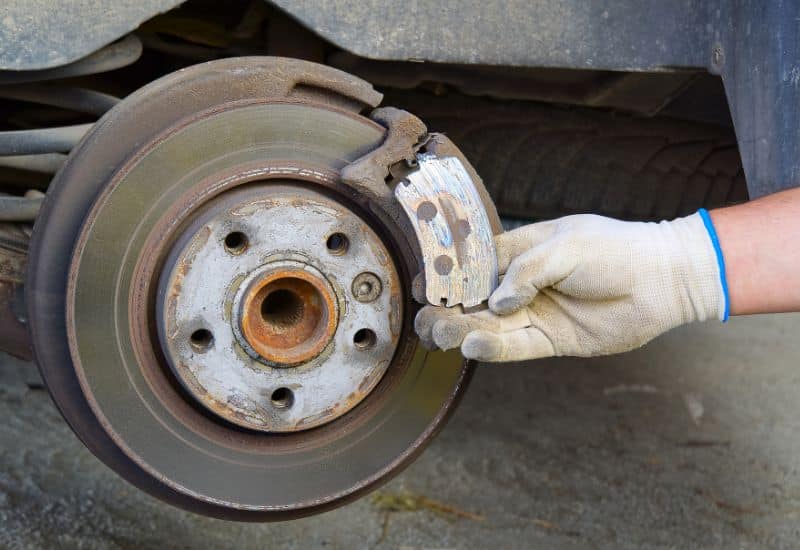
Low-quality brake pads that use a lot of fillers and/or have a low metal content can be prone to degrading under the heat and friction of hard braking, which can deform the surface of the rotors over time.
Low-quality brake pads are also prone to uneven wear and can even start to glaze material onto the surface of the brake rotors.
4. A Stuck Brake Caliper
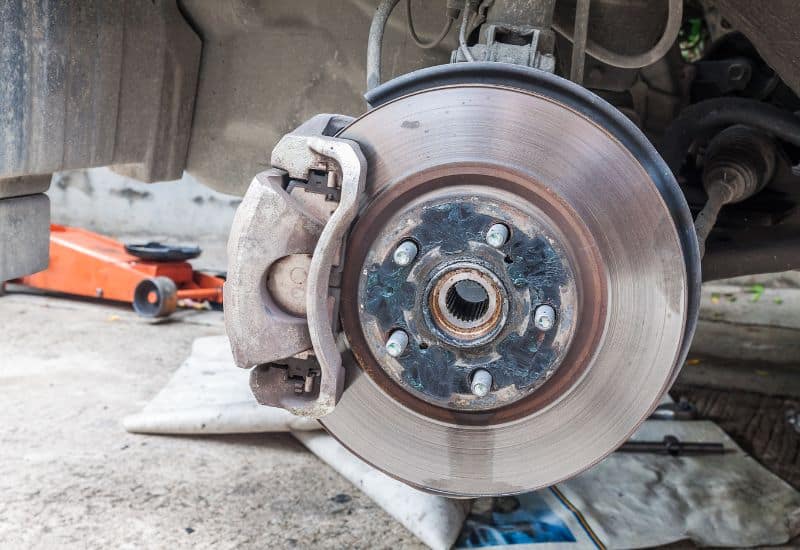
If a fault in a brake caliper causes it to stick or seize, the brake pad can press against the rotor, causing persistent severe friction, which causes the rotor to warp. It can also cause grooves in the rotor where the brake pad touches or if it makes contact with the caliper.
A stuck caliper can be caused by poor brake system lubrication or corrosion on the caliper slides. If you recently leaked a broken line and the system wasn’t bled correctly, a bubble in the line could lead to just one caliper, causing it to stick.
The early signs of a stuck brake caliper start out as the car pulls to one side when you brake. If the caliper seizes or remains stuck in a compressed state, the car can pull hard to one side when you’re driving down the road.
You might even start to hear metallic grinding noises as the pad starts to wear away and the warped rotor starts to contact the harder metal of the brake caliper.
5. Over-Torquing or Improper Tightening of Lug Nuts
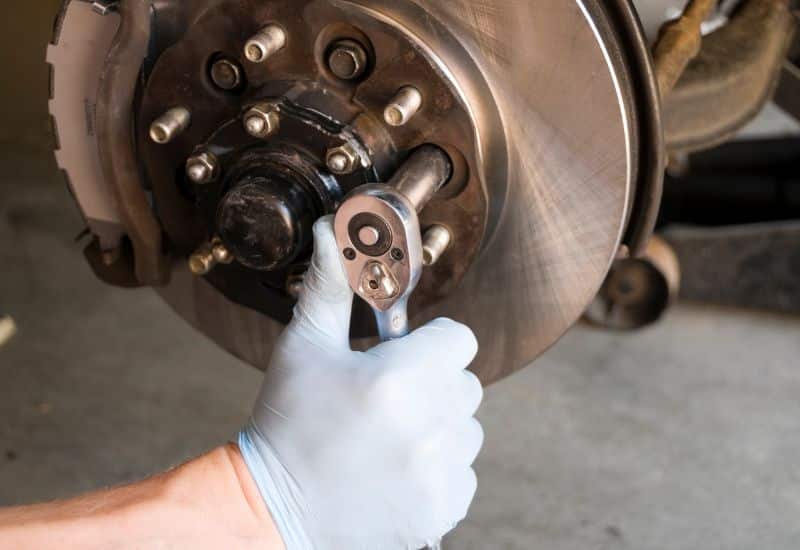
If you’ve recently changed a tire or performed a DIY tire rotation without evenly tightening all the lug nuts, the variance in the relationship between the wheel, the rotor, and the brake caliper can gradually cause the rotor to warp.
This will also make the steering wheel shudder very easily when braking, and you might even notice a change in the handling when you go around corners. You might notice this more on one side of the car or feel like the car pulls when you brake especially if you’ve recently had a single tire changed.
6. Bad Wheel Bearings
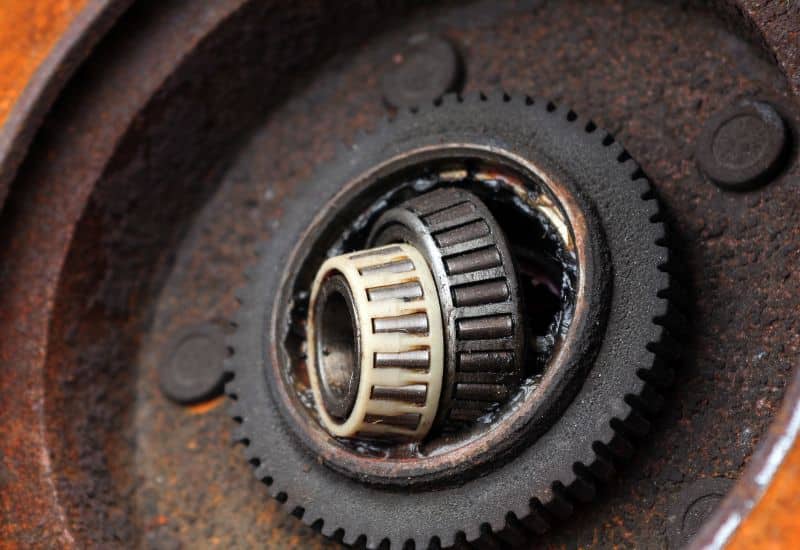
Bad wheel bearings can affect the orientation of the entire wheel, causing it to rub excessively on the rotor until it deforms and warps the surface. In this scenario, you’ll hear a strange grinding noise from the instant you set out from a stop. The noise will get louder with the car’s speed until, finally, it vanishes with the ambient road noise.
Then you step on the brakes, and you might hear grinding and squealing with a lot of shuddering in the steering wheel. When you start out again, the bearing starts to grind, and you repeat the experience all over again.
This is a double jeopardy situation. Not only can the bad rotors make braking dangerous, but the bad wheel bearings can damage the wheel assembly to the point that the wheel itself comes off at speed!
How To Tell Whether the Front or Rear Rotors Are Warped
The front brakes tend to see more stress than the back brakes, which can lead to warped rotors in the front, even if the back brakes are perfectly fine. If the front rotors are warped, you’ll feel the shuddering vibrations in the steering wheel and probably the brake pedal. If you feel the vehicle vibrating but the shuddering isn’t any worse in the steering wheel, then the back rotors are likely warped.
How to Confirm Warped Rotors
If you’ve been noticing symptoms of warped rotors, like shuddering steering, squeaking brakes, and vibrations in your steering wheel, the easiest way to confirm that it’s indeed warped rotors is to perform a brake inspection. You can usually do this at any service center or oil change shop offering tire rotation.
A brake inspection usually costs around $50 or less. They can confirm that it’s indeed warped rotors as well as identify any other brake system components that might be damaged.
Can Warped Rotors Be Resurfaced? (Or Should They be Replaced?)
If you catch warped rotors symptoms early, it might be possible for a mechanic to smooth out or resurface the rotors with a lathe. Depending on where you go, this could be a cheap fix costing you around $25 to $50 per rotor.
The thing you have to worry about here is that the iron of the rotor is still a heat-stressed metal that has already experienced some degree of metal fatigue. This makes the rotor very prone to warping again in the future.
It’s not uncommon for resurfaced rotors to warp again in a few months or within 10,000 miles. At that point, whatever you spent on the original resurfacing is basically just wasted cash out of your pocket.
How Much Does It Cost To Fix A Warped Rotor?
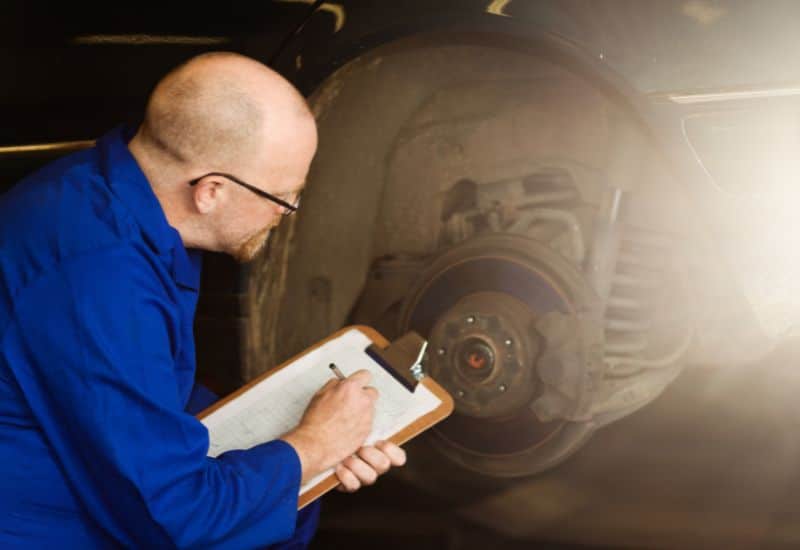
| Service | Cost Range |
| Replace warped rotors (per axle) | $240 – $485 |
| Labor costs for rotor replacement | $175 – $250 |
| Cost of new rotors | $65 – $235 |
| Replace warped rotors and pads (per axle) | $250 – $500 |
| Add cost for damaged brake caliper | $110 – $145 |
| Replace and repack single wheel bearing | $125 – $300 |
Sometimes, you can have your warped rotors resurfaced. Usually, you need a mechanic to completely replace the rotor and repair other components that might have been damaged or deformed along the way.
Having a minorly warped rotor resurfaced costs around $25 to $50 per rotor. However, you should consider this a short-term fix that’s good for less than a year.
Resurfacing your rotors is usually beyond what the average DIY mechanic can handle. If you haven’t done it before or you don’t have the right tools, the wise move is to take it to a mechanic.
If you resurface your rotors or have a mechanic do it, you should also strongly consider replacing the brake pads. Most of the time, the brake pads deform to match the shape of the warped rotor. If you use the same deformed pads, you run the risk of the pads damaging the resurfaced rotor all over again.
Replacing warped rotors typically costs around $240 to $485 per axle, with labor costs generally ranging from $175 to $250 and the price of new rotors falling between $65 and $235. You almost always have to replace the brake pads to make sure they have a smooth relationship with the new rotors.
The cost to replace warped brake rotors and pads simultaneously can range from $250 to $500 per axle.
If the warped rotors also damaged a brake caliper, you can add another $110 to $145 to the final mechanic’s bill.
If the warped rotors were caused by bad wheel bearings or the wheel bearings were damaged by driving on warped rotors for too long, then you’ll need to have them replaced to ensure the orientation between the wheel and the new rotors doesn’t cause further damage.
The cost to have a mechanic replace and repack a single wheel bearing ranges from $125 to $300.
Frequently Asked Questions
Is It Dangerous To Drive A Car With Bad Rotors?
You might be able to get away with driving on warped rotors for a while, but continuing to drive with damaged or distorted rotors poses a significant risk. This compromised braking efficiency extends your stopping distance. It diminishes your capacity to stop quickly in case of an emergency, to the point where you might not be able to stop short in time at a quick-changing set of lights or be able to slow down in time when someone cuts you off on the highway.
Over time, the safety hazards of driving with warped rotors escalate. If not addressed, a severely distorted rotor can cause brake pads to wear away, leading to contact between the rotor and the caliper. This can then result in the severing of a hydraulic brake line, causing the system to bleed out brake fluid quickly. At this critical point of catastrophic brake failure, your brake brakes will quickly become inert, putting a serious risk to you and other drivers on the road.
Can Bedding in the Pads Correct the Warped Rotor Behavior?
Bedding in your brake pads won’t resurface rotors that are already warped by excessive friction or uneven pad wear. However, bedding in your brake pads, when new, can go a long way toward reducing the risk of warping your rotors later. It can also reduce the risk of organic pad material glazing on the rotor over time.
To bed, in your brakes, you need to speed up to 35 MPH and then lightly brake until you reach 5 MPH without coming to a complete stop. Do these three to five times to warm up the brakes. Then, speed up to 55 MPH and brake hard to slow the car down to 5 MPH without stopping. Repeat this another three to five times.
Then, take the car for a casual drive on the highway for 10 to 15 minutes before parking it to let the brakes cool for at least an hour.
This simple process will help ensure a smooth relationship between your new brake pads and rotors while minimizing the risk of adherent friction.
Conclusion
The symptoms of warped brake rotors often start out as subtle squeaking sounds when braking and increased braking distance before coming to a complete stop. As the rotors continue to deform and wear abnormally on the brake pads, you’ll likely notice the brake pedal and/or steering wheel shuddering along with metallic grinding noises.
These are serious signs that your car’s brake system is breaking down. At the very least, you need to schedule a professional brake inspection to assess the severity of the problem.
The most common cause of warped brake rotors is bad driving habits with an excessive amount of hard braking. Riding the brake down hills or stop-and-go traffic can also add excess friction to the equation.
Though there are also mechanical failures like stuck brake calipers, low-quality brake pads, and bad wheel bearings, which can cause excess friction on the rotors; as the heat builds up, the metal deforms, and deep grooves can be gouged into the rotor by uneven brake pads or direct contact with the brake caliper.
The sooner you get a brake inspection, the lower the repair cost will be. If you’re lucky and you caught it early, you might be able to resurface the warped rotors and install new brake pads for less than $200 per axle.

Written By
Jason Farrell
Jason Farrell is a certified master technician, the editor of Mechanic’s Diary in Pittsburgh, Pennsylvania. He is ASE (Automotive Service Excellence) certified and earned a Bachelor’s Degree in Automotive Technology from Pittsburg State University. With nearly 18 prior years of experience in the automotive field, he has extensive knowledge about Domestic, European, and other foreign makes and models of cars and light trucks. Jason’s experience working as a technician and service manager at dealerships, gave him the experience and know-how of most aspects of inspection, diagnosis, and repair from engine and drivability to electrical, HVAC, brakes, steering and suspension and everything in between.


